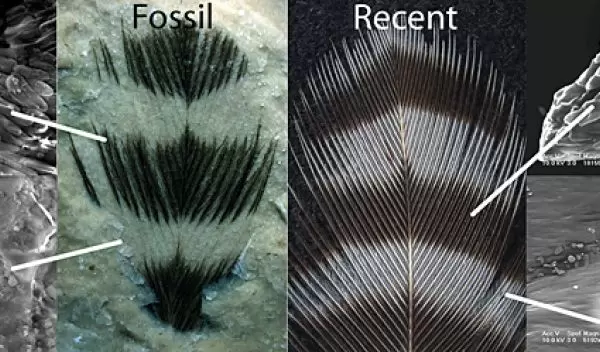
Fossil Feathers Preserve Evidence of Color
Traces of organic material found in fossil feathers are remnants of pigments that once gave birds their color, according to scientists whose research results are published online this week in the journal Biology Letters.
Their findings open the potential to depict the original coloration of fossilized birds and their ancestors, the dinosaurs.
"These results may lead to predicting feather color in ancient birds and related species," said H. Richard Lane, program director in the National Science Foundation's Division of Earth Sciences, which funded the research. "Through this understanding, we may be able to learn about their ecology and behavior."
Closer study of a number of fossilized bird feathers by scientist Jakob Vinther of Yale University in New Haven, Conn., revealed that organic imprints in fossils--previously thought to be carbon traces from bacteria--are fossilized melanosomes, the organelles that contain melanin pigment.
"Birds have spectacularly colored plumage often used in camouflage and courtship display," said Vinther. "Feather melanin is responsible for rusty-red to jet-black colors, and produces glossy iridescence.
"That melanin can resist decay for millions of years."
Working with Yale paleontologist Derek Briggs and Yale ornithologist Richard Prum, Vinther analyzed a striped feather found in 100 million-year-old rocks in Brazil.
The team used a scanning electron microscope to show that dark bands of the feather preserved the arrangement of the pigment-bearing structures as a carbon residue--organized much as the structures are in a modern feather. The light bands showed only rock surface.
In another fossil of a bird from the Eocene Epoch--55 million years ago--in Denmark, there were similar traces in the feathers surrounding the skull. That fossil also preserved an organic imprint of the eye and showed structures similar to the melanosomes found in eyes of modern birds.
"Many other organic remains will presumably prove to be composed of melanin," said Vinther. He expects that fur of ancient mammals and skin from dinosaurs preserved as organic imprints will likely be the remains of melanin.
"Now that we have demonstrated that melanin can be preserved in fossils, scientists have a way to reliably predict, for example, the original colors of feathered dinosaurs," said Prum.


